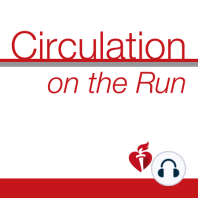17 min listen
Circulation February 26, 2019 Issue
ratings:
Length:
25 minutes
Released:
Feb 25, 2019
Format:
Podcast episode
Description
Dr Carolyn Lam: Welcome to Circulation on the Run, your weekly podcast summary and backstage pass to the journal and its editors. I'm Dr Carolyn Lam, associate editor from the National Heart Center and Duke National University of Singapore. Dr Greg Hundley: And I'm Greg Hundley, associate editor and director of the Pauley Heart Center from VCU Health in Richmond, Virginia. Dr Carolyn Lam: So, Greg, are we any closer to the holy grail of safe ED discharge for acute heart failure based on a risk score? Well, we're going to be discussing that coming right up after Greg and I share about the papers that we'd like to discuss today. Lovely issue, isn't it? Dr Greg Hundley: Yup, and time to get your coffee and bring it up. My first paper, Carolyn, is from Michael Chu from London Health Sciences Center, and is really investigating the surgical management of thoracic aortic disease, and looking at the impact of gender or sex related differences. Sex related differences have not been thoroughly studied. This group looked at a total of 1653 patients, 30% were women, who underwent thoracic aortic surgery with hypothermic circulatory arrest between the years of 2002 and 2017 across Canada in 10 institutions. Well, women underwent less aortic root reconstruction, including aortic root replacement, Ross procedures, or valve sparing root operations. But, even with less invasive, the women experienced higher rates of mortality, 11% versus 7%, stroke, and that composite of the thoracic surgeons' adverse events. On multi variable analysis, female sex or women was an independent predictor of overall mortality, stroke, and those comorbidities. Dr Carolyn Lam: Greg, you know how much I love these papers, so I'm going to repeat that. You're saying the women received less ominous procedures and yet had worse outcomes, and this was independent of the clinical covariances, right? Dr Greg Hundley: Absolutely. Putting all this together, women underwent thoracic aortic surgery a little bit older, and with larger index aortic aneurysm size than men. Intraoperatively, women undergo fewer concomitant procedures, such as the aortic root repairs, and things that you just mentioned. But nevertheless, women experience significantly worse outcomes identified as an independent predictor of mortality, stroke, and that composite endpoint for mortality, morbidity, after multi variable analysis. What should we think about this? Well, sex specific considerations are important when considering thoracic aortic surgery and future research should focus on the development of a personalized approach to thoracic aortic surgery with respect to gender. For example, utilization of maybe lower size thresholds for women for aortic aneurysms should be considered, and for earlier interventions, and improved outcomes. Carolyn, tell me about one of your papers. Dr Carolyn Lam: All right, so I chose a paper looking at the stroke outcomes in the COMPASS trial. Now, let's remind everybody that the COMPASS trial, where patients with stable coronary artery disease or peripheral artery disease, and randomly assigned to receive aspirin 100 milligrams daily, rivaroxaban five milligrams twice daily, or the combination of rivaroxaban 2.5 milligrams twice daily plus aspirin. Patients requiring anticoagulation with a stroke within a month had a previous lacunar stroke or intracerebral hemorrhage were excluded. Now, in the current paper, and this is from Dr Sharma from Population Health Research Institute, and their colleagues, basically they looked at a detailed analysis of the stroke by type, predictors, and anti-thrombotic effects in the key subgroups. They found that the combination of low dose rivaroxaban
Released:
Feb 25, 2019
Format:
Podcast episode
Titles in the series (100)
Circulation January 24, 2017 Issue: Circulation Weekly: Your Weekly Summary & Backstage Pass To The Journal by Circulation on the Run
